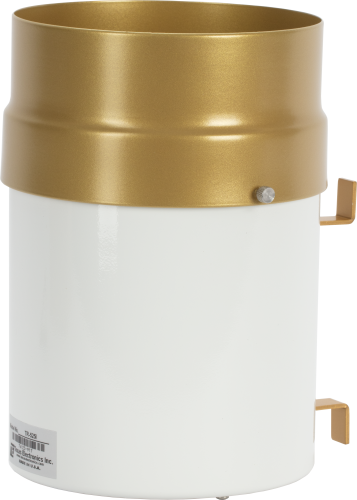
Resumen
The TE525, manufactured by Texas Electronics, has a 6 in. orifice and measures rainfall in 0.01 in. increments. It is compatible with all Campbell Scientific data loggers, and it is widely used in environmental monitoring applications.
Leer másVentajas y características
- Accuracy is ±1 percent at rates up to 1 in./hr
- Compatible with most Campbell Scientific data loggers
- High precision—tips at 0.01-in. increments
Imágenes

Descripción detallada
The TE525 funnels precipitation into a bucket mechanism that tips when filled to its calibrated level. A magnet attached to the tipping mechanism actuates a switch as the bucket tips. The momentary switch closure is counted by the pulse-counting circuitry of our data loggers.
Productos similares
Preguntas frecuentes
Número de FAQs relacionadas con TE525-L: 7
Expandir todoDesplegar todo
-
A TE525-L can be converted to a TE525MM-L and vice versa because the inner tipping mechanisms are the same. To convert a TE525-L or TE525MM-L to a TE525WS-L, the rain gage must be sent in to Campbell Scientific to change the tipping mechanism. If an 8 inch funnel is used on a TE525-L or TE525MM-L without changing the tipping mechanism, the multipliers for the rain measurement will change. For information about these multipliers, see the TE525 Instruction Manual.
-
The CS705 Tipping Bucket Snowfall Adapter cannot be used directly with the TE525-L or TE525MM-L because of the funnel size. To make the rain gages compatible, they can either be sent to Campbell Scientific to be converted to a TE525WS-L, or an 8 inch funnel can be installed. If the funnel is used, see the instruction manual for the appropriate multipliers, as they will change.
-
Not enough tips or too many tips.
-
The 260-953 Alter-type rain gage wind screen consists of 32 heavy metal leaves that hang freely and swing as the wind moves past them. The swinging leaves act as a wind damper and help minimize the effect of wind on the rain measurements without adding additional turbulence.
-
When a rain gage is out of calibration, it is usually because of the buildup of dirt and grime on the internal surfaces of the tipping bucket mechanism. Cleaning the internal surfaces usually brings the rain gage back into calibration. It is also possible that a rain gage is out of calibration because it is no longer level.
To minimize the possible occurrence of calibration errors, perform routine cleaning and maintenance of the rain gage at least once every three months. The environmental conditions at a particular site may require a facility to perform cleaning, leveling, and maintenance on a much more frequent schedule.
-
The most common errors are either that the rain gage appears to have drifted out of calibration or that the tips are not being correctly recorded by the datalogger.
-
To incorporate a sensor that is compatible with wireless sensor interfaces into a wireless network, a CWS900-series wireless sensor interface is needed, as well as an A205 CWS-to-PC interface to configure it.
Compatibilidad
Nota: lo siguiente muestra información de compatibilidad notable. No es una lista de todos los productos compatibles.
Dataloggers
| Producto | Compatible | Nota |
|---|---|---|
| CR1000 (retired) | ||
| CR1000X (retired) | ||
| CR300 (retired) | ||
| CR3000 (retired) | ||
| CR310 | ||
| CR350 | ||
| CR6 | ||
| CR800 (retired) | ||
| CR850 (retired) |
Información de compatibilidad adicional
Mounting
The TE525 rain gage mounts to a CM300-series Mounting Pole or a user-supplied 1.5-in. IPS pole. Several pedestal options are available to secure a CM300-series pole to the ground (see Ordering Information). Accurate measurements require the gage to be level.
Snowfall Adapter
The TE525 cannot be directly used with our CS705 rainfall adapter. However, the CS705 is compatible with the TE525WS, and the TE525 can be converted to a TE525WS by returning it to Campbell Scientific (requires an RMA).
Wind Screen
Campbell Scientific offers the 260-953 Wind Screen to help minimize the effect of wind on the rain measurements. This wind screen consists of 32 leaves that hang freely and swing as the wind moves past them.
Especificaciones
| Sensor Type | Tipping bucket with magnetic reed switch |
| Material | Anodized aluminum |
| Operating Temperature Range | 0° to 50°C |
| Resolution | 1 tip |
| Volume per Tip | 4.73 ml/tip (0.16 fl. oz/tip) |
| Rainfall per Tip | 0.254 mm (0.01 in.) |
| Measurement Uncertainty | 1.0% up to 50 mm/h (2 in./h) |
| Cable Type | 2-conductor shielded |
| Orifice Diameter | 15.4 cm (6.06 in.) |
| Height | 24.1 cm (9.5 in.) |
| Cable Weight | 0.1 kg (0.2 lb) per 3.05 m (10 ft) length |
| Tipping Bucket Weight | 0.9 kg (2.0 lb) |
Documentos
Folletos producto
Casos de aplicación
In 2022, as Hurricane Fiona unleashed relentless rain on Puerto Rico, the Puerto Rico Landslide......leer más
Overview In May 2019, the Government of Zambia embarked on the Climate Adaptation Water and Energy......leer más
In 2013, a sinkhole appeared next to a historic home in southern Louisiana. Over the......leer más
Scientists and land-use managers have long recognized the importance of forest lands for their role......leer más
Networks using the ALERT protocol are designed to give immediate access to data that indicates......leer más
The Delaware Environmental Observing System (DEOS) is a real-time system dedicated to monitoring environmental conditions......leer más
The Austin College Weather Station (ACWX) is located on Austin College's Sneed Environmental Research Area,......leer más
North Dakota agriculture ranks high in the nation’s crop production: No. 1 in durum and......leer más










